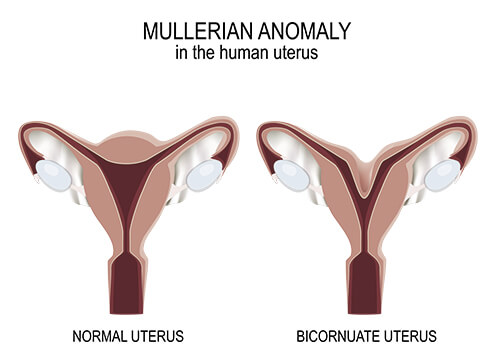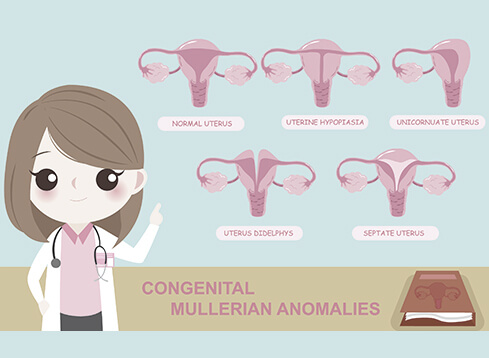Developmental anomalies of the female reproductive system represent some of the most fascinating disorders that obstetricians and gynecologists encounter. Most of these anomalies are due to the developmental defects of the mullerian duct system. Congenital uterine anomalies may lead to symptoms such as pelvic pain, prolonged or otherwise abnormal bleeding at the time of menarche, recurrent pregnancy loss, or premature delivery, and thus may be identified in girls and women who present with these disorders. Some congenital anomalies may be suspected because of associated findings on physical examination, such as a longitudinal vaginal septum. Others may be detected when imaging studies are performed to evaluate patients with infertility, symptoms related to non reproductive organ systems, or routine ultrasounds.

You should visit your gynecologist whenever you have history of delayed menarche, history of infertility or an X-Ray (HSG) demonstrating any deviation from the normal image, or ultrasound showing any abnormal findings.
Book an AppointmentMost of the developmental anomalies of the mullerian ducts are accidental findings. Conditions such as transverse vaginal septum or imperforate hymen can cause delayed periods with symptoms of cyclical pain in abdomen or pelvic pain. Uterine septae can cause hypoperfusion of the healthy embryo, hence causing early miscarriage. Change in the shape of the uterus can cause abnormal fetal presentations during pregnancy such as transverse presentation or breech presentation, increasing the need for cesarean section.

We at Queen’s Gynecology believe in timely intervention of uterine and pelvic anomalies. Most of the time, women are unaware of these findings, these are incidental findings during surgery or during investigations. Our aim is to identify these anomalies using latest modalities such as 3d/4d ultrasound, laparoscopy and hysteroscopy and correct them simultaneously.
1. Which uterine anomalies are most common?
Uterine anomalies, also known as uterine malformations or congenital uterine anomalies, are variations in the shape and structure of the uterus that develop during fetal development. The most common uterine anomalies include septate uterus, bicornuate uterus, and unicornuate uterus.
These anomalies can hugely impact reproductive health, potentially causing difficulties in conceiving or maintaining pregnancies.
2. What is the best test for uterine anomalies?
Here are some of the best tests for diagnosing uterine anomalies:
The choice of which test or combination of tests to use depends on the specific clinical context and the complexity of the anomaly.
3. What are the signs of a damaged uterus?
A damaged uterus can present with various signs that may indicate underlying issues. Common signs of a damaged uterus include:
If you experience any of these signs, it's important to seek medical evaluation. At Queen's Gynecology, we perform appropriate diagnostic tests to determine the underlying cause and recommend suitable treatment options to address the damaged uterus and associated symptoms.
Dr Priya is an amazing doctor. She is so generous. I had been consulting her since my first pregnancy. It was a c-sec. Throughout my pregnancy she was always there for my late night calls and doubt sessions. I got recovered within a week after surgery. Even now I am pregnant with a second kid after a year of my first delivery. I am more confident and a happy mother because of her. Thank you Dr. Priya. I really can't express in words.
Dr. Priya is very patient and empathetic person and answer all your queries with a detailed honest response. She is also available on WhatsApp which is a great help in times of unseen emergencies. She is very knowledgeable and has a very pleasant personality. She did not recommend any unnecessary tests and medication. Even for females over 40+, who are struggling with the harmonal issues, her consultation is boon. Thanks Dr Priya for being there for us!
Dr. Priya is very patient and empathetic person and answer all your queries with a detailed honest response. She is also available on WhatsApp which is a great help in times of unseen emergencies. She is very knowledgeable and has a very pleasant personality. She did not recommend any unnecessary tests and medication. Even for females over 40+, who are struggling with the harmonal issues, her consultation is boon. Thanks Dr Priya for being there for us!